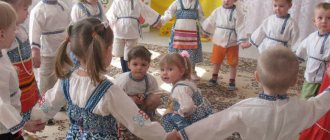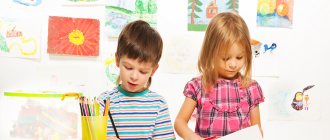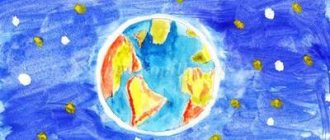Card file: “Conversations with children about a healthy lifestyle” (Senior group) TOPIC: “Child and health”
Municipal preschool educational institution Suslongersky kindergarten “Forest Fairy Tale”
Card file: “Conversations with children about a healthy lifestyle”
(Senior group)
TOPIC: “Child and health”
Prepared by: teacher 1st quarter. categories Idrisova T.V.
2018
Card file: “Conversations with children about a healthy lifestyle”
(Senior group)
TOPIC: “Child and health”
P.s.: to develop children’s initial skills in protecting life and health. Based on situational moments, learn to draw conclusions about life safety. Foster a sense of mutual assistance and a desire to help each other.
Progress of the lesson:
1) Talk about health, find out how children understand the word “health”:
health is the best wealth;
healthy - everything is great.
2) Bring in a casually dressed boy doll. Please note that dressing this way can harm your health.
3) Analyze situations when you need to behave carefully and take care of your health (how to walk on a wet floor so as not to slip; how to go down the stairs; how to dress when going for a walk).
Reading poems - advice.
OCTOBER
TOPIC: “Vegetables and fruits are healthy products”
P.S.: clarify children’s knowledge about healthy foods, their purpose for health and good mood. Fix the names of vegetables and their taste. Cultivate a desire to eat fruits.
Progress of the lesson:
1) Invite the children to remember what time of year it is now, show the gifts of autumn - a basket of fruits (examine and describe them).
2) Tell children about the health benefits of fruits for children and adults.
3) Ask what fruits parents buy for their children, remind them that in order to be strong and healthy, they must eat fresh fruits.
D/i “Guess the taste”, “Wonderful bag”.
NOVEMBER
TOPIC: “Personal hygiene”
P.s.: develop in children an understanding of the importance and necessity of hygiene procedures. Find out what accessories children use when washing. Learn to read clearly and emotionally.
Progress of the lesson:
1) Reading an excerpt from Mayakovsky’s poem “What is good and what is bad.”
2) Questions:
Which boy do you like better?
Why did you like the neat, neat boy?
Did anyone like the other boy?
Why didn't you like it?
What toiletries do you need to wash away dirt and be clean?
What, besides soap and a sponge, is needed for washing?
Invite children to show how children wash their hands and face (imitation movements)
3) Offer to learn a pure phrase:
Milu's mom
With soap soap...
DECEMBER
TOPIC: “Human Body”
P.s.: Clarify children’s knowledge of what parts the human body consists of, talk about the role of the senses. Learn to understand the meaning of certain parts of the body: arms, legs, head, torso. It is clear to answer the teacher’s questions. Cultivate the desire to grow up strong and healthy.
Conversations with senior preschool children “Take care of your health”
Most often, a cold begins with a runny nose. The nose is the first to fight germs. First of all, it begins to produce as much mucus as possible. With its help, the nose tries to delay the invasion of microbes, preventing them from penetrating the throat and lungs. When there is a lot of mucus, the nose tries to get rid of it. How? And like this: a-a-pchhi! But when sneezing, you need to cover your nose with a handkerchief, otherwise we can infect everyone who is nearby with our germs.
What to do when a runny nose starts?
First, you need to dress warmly. And the main thing is to keep your feet warm. Even the ancient Greeks noticed a connection between the condition of the legs and a runny nose. I got my feet wet and got a runny nose. Therefore, take a bowl of hot (but not scalded) water, you can add dry mustard, put your feet in it and sit and warm up. Then dry your feet and quickly put on warm wool socks. Don't forget about hot drinks. Tea with honey, raspberries, other medicinal herbs, and warm milk are suitable. The main thing is more warmth. It turns out that the nose can be hardened. To do this, you need to rinse it with salted water twice a day (half a teaspoon of salt per glass of water at room temperature).
Conversation on the topic “Be careful in games.”
Target:
developing safe behavior skills while walking.
Discuss with the children what dangerous situations during a walk are shown in the picture. Invite them to think and draw conclusions about the characters’ incorrect behavior. Consider what consequences the most harmless, at first glance, pranks can lead to. In order for a child to learn and follow the rules of safe behavior while walking, it is necessary to discuss possible situations and tell them how to avoid them. This must be done carefully and consistently so as not to scare the child.
Explain to children that they should not walk close to the swing when someone is swinging on it - they can get a severe head injury. You cannot push and fumble at the top of the slide or on the steps, pull the person in front off them, pull the legs, jacket or pull the hood.
There are often bushes growing in the yards around the site. It is necessary to make it clear to children that under no circumstances should they eat berries that ripen on the bushes, do not crush them if “making jam or soup,” and do not lick dirty fingers - this can cause allergies or poisoning.
Tell them that you need to play carefully in the sandbox.
After all, its contents could contain anything: broken glass, syringes, cigarette butts, animal feces. And if any of the above occurs when the child is playing in the sand, you need to ask the mother to remove it without touching anything with your hands. Also explain to your child that when playing with sand, you should not throw it, pour it into another child’s collar or hair, and you should not pull your hands towards your face or into your mouth.
Forming children's ideas about a healthy lifestyle or how to instill the habit of being healthy
Preschool age is one of the most crucial periods in the life of every person. It is during this age period that the foundations of health and proper physical development are laid, motor abilities are formed, interest in physical culture and sports is formed, and personal, moral-volitional and behavioral qualities are cultivated.
Forming ideas about a healthy lifestyle in preschoolers will be most successful if:
· the content of the concept of “healthy lifestyle” has been determined, including both biological and social concepts, as well as environmental ones, and revealing the dependence of a healthy lifestyle on the state of the surrounding ecological environment;
· a pedagogical technology has been designed, including forms, methods, conditions, principles, stages of the formation of ideas about a healthy lifestyle: “health” and “human lifestyle”, “dependence of health and lifestyle on the state of the surrounding social and ecological environment”, “healthy image life is the basis for maintaining and strengthening health"
· a model of interaction between subjects of the educational process has been developed, which involves training teachers to solve the problems of developing a healthy lifestyle in children, for methodological and educational work with parents, and the direct influence of teachers and parents on children.
Adults themselves rarely adhere to these rules in everyday life, and children see this well. In addition, following the necessary rules of a healthy lifestyle requires significant volitional efforts from a person, which is extremely difficult for a preschool child who has an insufficiently formed emotional-volitional sphere.
In order to actively influence a child’s position in relation to his own health, it is necessary to know, first of all, that the state of health itself is formed as a result of the interaction of external (natural and social) and internal (heredity, gender, age) factors. There are several components of health:
1. Somatic health is the current state of the organs and systems of the human body, the basis of which is the biological program of individual development.
2. Physical health - the level of growth and development of organs and systems of the body.
3. Mental health is a state of the mental sphere, the basis of which is a state of general mental comfort.
4. Moral health, the basis of which is determined by the system of values, attitudes and motives of human behavior in society. Ideas about healthy lifestyle in children of different ages.
A child’s attitude towards his health is the foundation on which the building of the need for a healthy lifestyle can be built. It originates and develops in the process of the child’s awareness of himself as a person and personality. A child’s attitude towards health directly depends on the formation of this concept in his consciousness. Children of primary preschool age understand what illness is, but they still cannot give the most basic characteristics of health. As a result, young children practically do not develop any attitude towards him. In middle preschool age, children develop an idea of health as “not a disease.” They talk about how they were sick, they have a negative attitude towards the disease based on their experience. But they still cannot explain what it means to be healthy and feel healthy. Hence the attitude towards health as something abstract. In their understanding, being healthy means not getting sick. When asked what needs to be done to avoid getting sick, many children answer that they should not catch a cold, not eat ice cream on the street, not get their feet wet, etc. From these answers it follows that in middle preschool age children begin to recognize health threats from the external environment (cold, rain, draft), as well as from their own actions (eating ice cream, getting their feet wet, etc.). In older preschool age, due to increasing personal experience, the attitude towards health changes significantly. But there is a confusion of the concepts of “healthy”, as big, good (that’s great!) and “healthy”, as not sick; children still correlate health with illness, but more clearly define threats to health as from their own actions (“you can’t eat dirty fruits”, “you can’t take food with dirty hands”, etc.), and from the external environment. With certain educational work, children correlate the concept of “health” with the implementation of hygiene rules. They begin to correlate physical education with health promotion and in its definition (like, in fact, adults) they put the physical component in first place. At this age, children (albeit still intuitively) begin to highlight both the mental and social components of health (“everyone there was screaming and swearing, and I got a headache”). But, despite the existing ideas about health and ways to preserve it, in general, the attitude towards it among children of senior preschool age remains quite passive. The reasons for this attitude lie in children’s lack of necessary knowledge about it, as well as their lack of awareness of the dangers of unhealthy human behavior for maintaining health. Unhealthy behavior in some cases brings pleasure (how nice it is to eat cold ice cream, drink a whole bottle of chilled lemonade, run through a puddle, lie in bed longer, etc.), and the long-term negative consequences of such actions seem distant and unlikely to the child. With targeted upbringing, training, reinforcement of hygiene rules in everyday life, and appropriate motivation for physical education, children’s attitude towards their health changes significantly. The attitude towards health as the greatest value in life (at a level that children can understand) becomes the basis for developing in children the need for a healthy lifestyle. In turn, the presence of this need helps solve the most important psychological and social task of developing a child’s position as a creator in relation to his own health and the health of others. The main components of a healthy lifestyle for children include:






